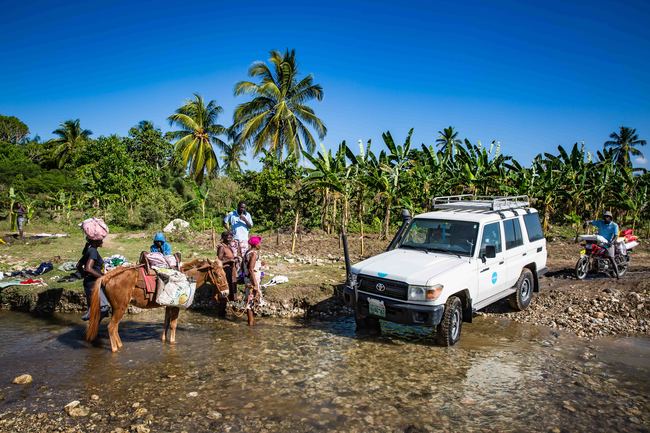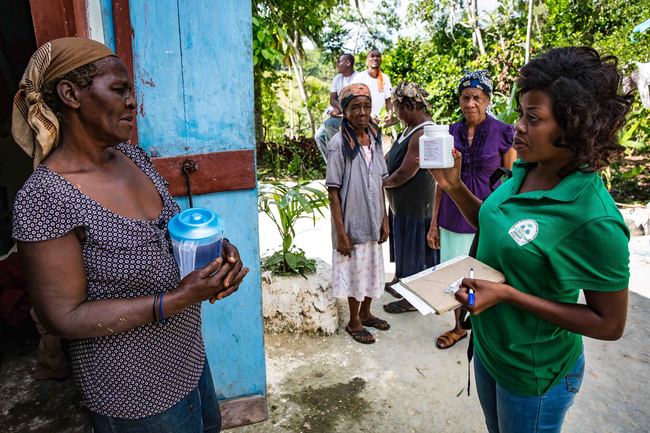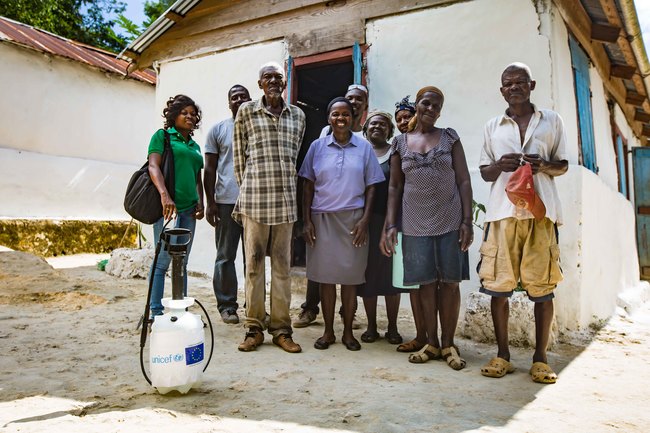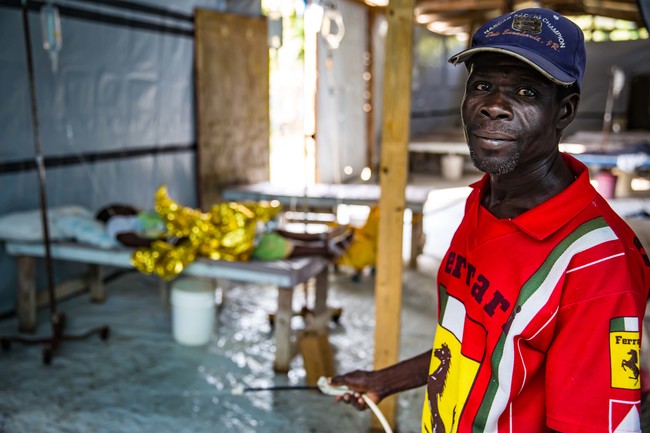Response and prevention: battling cholera in Haiti
2017-03-10
© UNICEF Haiti/2017/Bradley
Every suspected case of cholera sets in motion a standard rapid response mechanism that was established in 2013 and has since been applied all over the country with encouraging results.
By Cornelia WaltherThe number of suspected cholera cases in Haiti has been on the decrease - from over 350,000 suspected cases in 2011 to just over 41,000 in 2016. Each suspected case of cholera triggers a rapid response to protect against the disease from spreading. The ultimate goal? Eliminate cholera in Haiti by 2022.
SOUTH EAST DEPARTMENT/LA MONTAGNE, Haiti/ HONG KONG, 10 March 2017 - “Washing hands before eating and nursing the baby, washing hands after relieving myself, using Aquatabs to purify the water.” Miss Desloges, 64 years old, easily recites the actions that will protect her and her family from cholera with a calm, somewhat monotonous voice.
She seems well aware of the Do’s and Don’ts, and yet her husband, Emmanuel, fell sick the previous night and was taken to the Acute Diarrhoea Treatment Centre of Jacmel with suspected cholera.
Following intravenous rehydration, his condition has stabilized and after a few more days of oral rehydration at the centre he will be able to return home.

© UNICEF Haiti/2017/Bradley
As of January 2017, a total of 88 mobile rapid response teams are operational across Haiti. These teams focus on the most at risk communes, including locations affected by hurricane Matthew in October 2016.
Rapid response As with every suspected case of cholera, Emmanuel’s case set in motion the standard rapid response mechanism that was established in Haiti in 2013, and that has since been applied all over the country with encouraging results.
“Once we arrive at a location, we visit with the family of the patient first. We interview the relatives based on an established questionnaire concerning issues such as hygiene practices in the household, their usual water point, recent travel of the patient and his family, the patient’s occupation etc,” explains 32-year-old René Colon who has been working with Solidarite Internationale’s rapid response team since 2014. “Our aim is to identify the cause of the outeak as quickly as possible to avoid further spreading of the disease.”
As of January 2017, a total of 88 mobile rapid response teams are operational across Haiti. These teams focus on the most at risk communes, including locations affected by hurricane Matthew in October 2016. Every team is composed of both NGO and governmental agents to facilitate an efficient and coordinated response.
Protecting families and neighbours Once René has finished the interview, his colleague, 35-year-old Renie Fodoas, systematically disinfects the patient’s house and its immediate surroundings with chlorine to eliminate any residue of the cholera virus. This is a vital step in the process of preventing other family members from getting sick.
“The last component of our visit is sensitization and prophylaxis. We not only talk, but demonstrate, hands-on, how people can protect themselves from cholera,” says Josepha Bellita, 28 years, who represents the Ministry of Health within the team.
“Often people know what needs to be done. But as soon as the imminent risk of cholera is gone they fall back into their old behaviours, like fetching water from unprotected sources and not purifying their water,” she explains with a sigh.
After the demonstration session, the family is provided with a one-month supply of chlorine, soap and a bucket with a lid in which water can be treated prior to use.
Before the mobile team leaves, Josepha administers one dose of antibiotics to all household members. The objective of this dose is to establish a two week immunity shield and interrupt the chain of transmission.

© UNICEF Haiti/2017/Bradley
Once the response team arrives at a location, they visit the family of the patient first and interview the relatives about issues such as hygiene practices in the household, their usual water point etc

© UNICEF Haiti/2017/Bradley
The team systematically disinfects the patient’s house and its immediate surroundings with chlorine to eliminate any residue of the cholera virus. After the demonstration session, the family is provided with a one-month supply of chlorine, soap and a bucket with a lid in which water can be treated prior to use.
Isolate the bacteria By applying the described protocol not only to the home of the patient’s family, but also to the homes in its direct neighbourhood, the rapid response team establishes a ‘cordon sanitaire’ – a sanitary zone.
In René’s words: “We seek to isolate the bacteria and protect the patient’s neighbours.” After treating the homes, he and his team will continue to comb the village, looking for other acute diarrhoea cases and suspicious deaths.
In areas with massive cholera resurgence the mobile teams return to the same family after their initial visit to conduct post-distribution monitoring. The purpose is to see whether the households and others within the cordon sanitaire remember the preventive measures, and actually apply them.
Working together to eliminate cholera Since 2010, UNICEF has been supporting the Haitian government in the fight against cholera, including the development of the 2013 National Plan for the Elimination of Cholera.
In the past few years the number of suspected cholera cases has continuously decreased - from over 350,000 suspected cases in 2011 to just over 41,000 cases in 2016.
The progress that has been made on the long path towards elimination would not have been possible without the continued support from major donors, such as the European Commission department for Civil Protection and Humanitarian Aid (ECHO), and the solid partnership with the Government of Haiti, the United Nations System and with six non-governmental partners.
Despite the positive trend, we cannot become complacent as much remains to be done to protect children and their families in La Montagne and the rest of the Haiti to eliminate cholera by 2022.

© UNICEF Haiti/2017/Bradley
A patient receives treatment. In the past few years the number of suspected cholera cases has continuously decreased - from over 350,000 suspected cases in 2011 to just over 41,000 cases in 2016.









